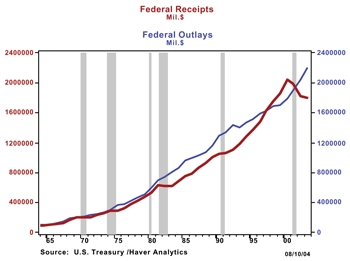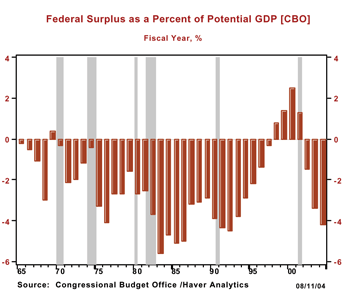Fiscal policy refers to the federal government’s spending and tax policies. The federal government is currently running a record deficit for the fiscal year 2004 that is a very expansionary fiscal policy even though the economy expanded at above average rates of growth from the second quarter of 2003 to the first quarter of 2004.
Economists typically expect budget deficits to stimulate economic growth. In contrast, budget surpluses tend to slow economic growth. Your question has significant public policy implications as well; many economists also believe that large government deficits tend to crowd out private sector investment and place upward pressure on interest rates.1
Chart 1

From surplus to deficit
From fiscal year 1998 to 2001, toward the end of the record economic expansion from March 1991 to March 2001, the federal government ran four consecutive budget surpluses. These fiscal surpluses, shown in Chart 1, had the effect of moderating the strong economic expansion then taking place, because budget surpluses tend to slow economic growth.
Projected future budget surpluses were provided as a justification for tax cut policies adopted after 2000.2 As Federal Reserve Bank Economist Kevin Lansing noted in his insightful April 13, 2001, Economic Letter, “Uncertainties in Projecting Federal Budget Surpluses”: “When thinking about these issues, it is important to keep in mind that ten-year budget projections are subject to considerable uncertainty.”
Chart 2

By 2001, the budget surplus began to melt away. Federal budget receipts began to fall sharply in 2001, shown by the heavy red line in Chart 2. The steep decline in tax revenues after 2000 reflects a series of tax cuts and a period of slower revenue growth resulting from the March 2001 to November 2001 recession and the decline in capital gains tax revenues following the dot-com bust (See the June 2003 Ask Dr. Econ and the National Bureau of Economic Research for more information about the 2001 recession).
Government spending also accelerated somewhat after 2001, shown by the thin blue line in Chart 2. However, as can be seen from Chart 2, the dramatic cuts in federal government revenues completely changed the budget outlook from one of large surpluses to one of large deficits after 2001. Moreover, current estimates—from the Congressional Budget Office (CBO) in March 2004—suggest that large deficits are likely to continue well into the future.3
How large is the current deficit?
In fiscal year 2003, the federal government ran a deficit of $375 billion. According to the CBO (March Baseline Estimate), the projected fiscal year 2004 deficit will be about $477 billion. Budget deficits tend to stimulate economic growth. Such a stimulative economic policy is often recommended during and immediately after recessions when economic growth is negative or weak. However, rapid growth in recent quarters has brought the economy closer to its potential long-run growth path. In the four quarters ending in March 2004, the U.S. economy averaged quarterly growth rates of about 5 percent, far faster growth than the non-inflationary potential real GDP growth rate the CBO estimates to be in the 3.3 percent range.4
Chart 3

Chart 4

In addition to the absolute measures of the deficit, one may also look at the deficit (or surplus or revenues or spending) as a percent of output or GDP. This ratio measures the size of the deficit relative to the overall economy. While this ratio also has risen sharply according to CBO data, reaching 4.2 percent in fiscal year 2004, shown in Chart 3, it still remains below the post-World War II high of 6.0 percent reached in 1983. Still, the turnaround in the ratio is dramatic, falling from a positive 2.4 percent in 2000 when the federal government surplus reached a peak to a negative 4.2 percent in 2004.
Impact on the economy: Increased borrowing by U.S. Treasury
One direct impact of the current record federal budget deficits is a sharp increase in the amount of borrowing the U.S. Treasury must undertake to finance the large annual deficits.5 That borrowing is then added to the total cumulative amount of outstanding borrowing from the public. Outstanding borrowing from the public reached an all time high of over $4 trillion in 2003, shown in Chart 4. Of course, as the deficit rises, so do the net interest payments the government must pay each year. In March 2004, the CBO estimated that annual net interest payments on the outstanding debt will rise from approximately $150 in 2004 up to $300 billion in 2009.
Impact on the economy: Higher interest rates
One key concern arising from the sharp increase in both the deficit and the deficit relative to GDP since 2001 is the potential impact that deficits might have on interest rates. For example, N. Gregory Mankiw, noted the following relationship in his 1998 textbook, Principles of Economics:
Thus, the most basic lesson about budget deficits follows directly from their effects on the supply and demand for loanable funds: When the government reduces national saving by running a budget deficit, the interest rate rises, and investment falls. Because investment is important for long-run economic growth, government budget deficits reduce the economy’s growth rate.
A 2003 study by Federal Reserve Board economist Thomas Laubach, titled, “New evidence on the interest rate effects of budget deficits and debt,” reported the following evidence of a link between an increase in the projected deficit-to-GDP ratio and long-term interest rates:
The estimated effects of government debt and deficits on interest rates are statistically and economically significant: a one percentage point increase in the projected deficit-to-GDP ratio is estimated to raise long-term interest rates by roughly 25 basis points (or 0.25 percentage point).
Monetary and fiscal policy
As the economy approaches mid-year 2004, it has experienced several quarters of well above average output growth. Furthermore, if recent growth rates persist through year-end 2004, output may finally approach the potential real output path for the economy. Not only will the economy be approaching its potential non-accelerating inflation growth path, but both fiscal and monetary policy will continue to stimulate economic growth.
In the case of monetary policy, the federal funds target rate, at 1 percent in May 2004, is at its lowest level in 45 years. Policymakers face concerns that both fiscal and monetary policy will continue to stimulate the economy as it approaches full employment. Continued stimulus may create the potential risk that the economy could begin to overheat and inflation could begin to rise from its current low level. (For more information on inflation, see Ask Dr. Econ for October 2002 and March 2004.) To review the Federal Open Market Committee’s current assessment of the economic risks facing the economy, see the Policy Statement the Committee issues after their most recent meeting.
References
(urls accessed on June 2004)
Lansing, J. Kevin. (2001) “Uncertainties in Projecting Federal Budget Surpluses.” Federal Reserve Bank of San Francisco, Economic Letter, No. 2001-10, April 13, 2001.
Laubach, Thomas. (2003) “New evidence on the interest rate effects of budget deficits and debt.” Financial and Discussion Series, Federal Reserve Board of Governors, 2003-12 (April).
Mankiw, N. Gregory. (1998) Principles of Economics. The Dryden Press/Harcourt Brace College Publishers, page 557.
Samuelson, Paul A., and William D. Nordhaus. (Most recent edition.) Economics. Irwin/McGraw-Hill Companies, Inc.
Stiglitz, Joseph E., and Carl E. Walsh. (2002) Principles of Macroeconomics. W.W. Norton & Company, New York.
Walsh, Carl E. (1999) “Projecting Budget Surpluses,” Federal Reserve Bank of San Francisco, Economic Letter, No. 99-27, September 10, 1999.
Endnotes
1. Stiglitz and Walsh, 2002, page 203, (see Wrap-Up: Government Deficits and Surplus), state that, “When government spends more than it receives in revenue, it must borrow in order to finance its deficit. The deficit reduces national saving, leading to higher real interest rates and lower private investment.”
2. See Lansing, 2001 and Walsh, 1999.
3. Congressional Budget Office, 2004 estimates (see Current Budget Projections, March Baseline Projections). With respect to future deficits,the CBOnotes that, “Those figures do not include possible future costsfor ongoing operations in Iraq and Afghanistan, which the Administration didnot include in its budget for 2005 and subsequent years.”
4. The Congressional Budget Office estimate for potential real GDP growth in 2004was 3.3 percent, according to data reported by Haver Analytics.
5. Foreign central banks have been majorpurchasers of U.S. Treasury debt in recent years. As of March 2004, foreign andinternational owners held $1.7 trillion,nearly 49 percent of the privately held U.S. Treasury securities. See TableOFS-2,Estimated Ownership of U.S. Treasury Securities.